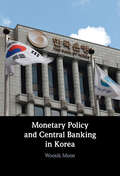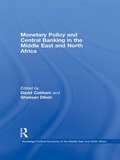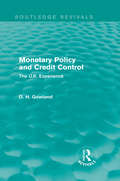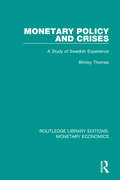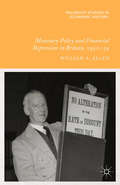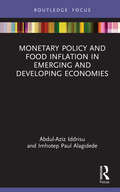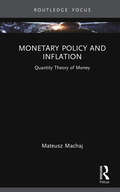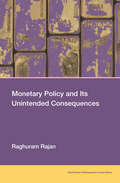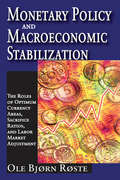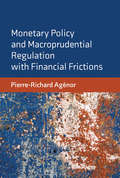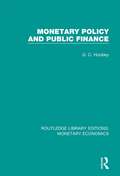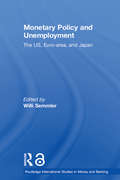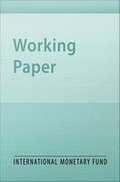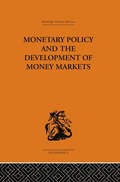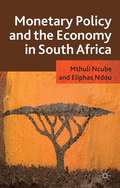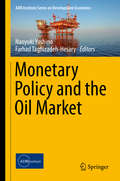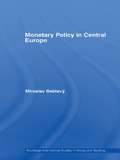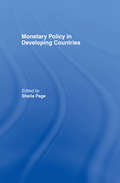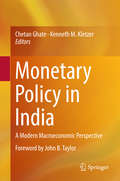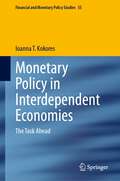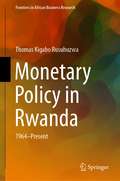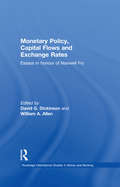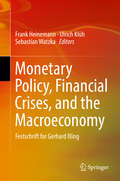- Table View
- List View
Monetary Policy and Central Banking in Korea
by Woosik MoonThis study is among the first to examine the theory and practice of monetary policy in South Korea. Woosik Moon provides a detailed analysis of the central bank of South Korea, one of the most successful and important economies in Asia. He covers everything from monetary policy to inflation targeting and macroprudential regulation, explaining how these policy tools were used to deal with the aftermath of the 2007-2011 financial crisis. He then brings his study into our current moment, speculating as to how the use of these policies will change in order to deal with the fallout of the Covid-19 pandemic. This book offers in-depth investigations and the provision of the most up-to-date information about the Bank of Korea's monetary and financial actions, serving as essential reading for central bankers and professionals of financial markets around the world, as well as anyone interested in monetary policy-making.
Monetary Policy and Central Banking in the Middle East and North Africa (Routledge Political Economy of the Middle East and North Africa)
by David Cobham Ghassan DibehThis book examines monetary policy, central banking and exchange rate regimes in the Middle East and North Africa. Part I covers central banking and monetary policy, while Part II covers monetary policy and exchange rate regimes. Some chapters focus on the monetary frameworks of particular countries, including Lebanon, Algeria, Syria, Tunisia, Morocco, and Turkey, outlining the different systems operated in each case, considering their successes and failures, and discussing important issues such as government policy, macroeconomic performance, inflation and inflation targeting, central bank independence and the impact of broader political economic developments on the conduct of monetary policy. Other chapters cover thematic issues across the whole region, including: central bank independence, operations of debtor central banks, the effect of exchange rates on inflation, and the effect on countries’ trade of alternative exchange rate regimes. Drawing on the insights of scholars and policy-makers, this book is a vital resource for anyone wanting to understand the economies of the Middle East and North Africa.
Monetary Policy and Credit Control: The UK Experience (Routledge Revivals)
by David H. GowlandThis book, first published in 1978, provides an analysis of British monetary policy and considers what techniques of monetary control were most appropriate to the context of the U.K. during the 1970s and 1980s. David Gowland answers crucial questions surrounding economic management in the period between 1971 and 1976, in particular whether rapid monetary expansion was the cause of the acceleration of U.K. inflation. With an analysis of the government’s experimentation with policy at its core, this is a unique study which will be of interest to students of monetary policy and recent British economic history.
Monetary Policy and Crises: A Study of Swedish Experience (Routledge Library Editions: Monetary Economics Ser.)
by Brinley ThomasThis book, first published in 1936, is both an instructive chapter in economic history and a stimulating period in the history of economic thought. The author examines the years of economic recovery in Sweden and the measures that the country adopted to cope with the crisis due to the War. This title will be of interest to students of monetary e
Monetary Policy and Financial Repression in Britain, 1951–59
by William A. AllenBritish monetary policy was reactivated in 1951 when short-term interest rates were increased for the first time in two decades. The book explores the politics of formulating monetary policy in the 1950s and the techniques of implementing it, and discusses the parallels between the present monetary situation and that of 1951.
Monetary Policy and Food Inflation in Emerging and Developing Economies (Routledge Focus on Environment and Sustainability)
by Abdul-Aziz Iddrisu Imhotep Paul AlagidedeThis book focuses on the impact of monetary policy and food price volatility and inflation in emerging and developing economies. The tendency for food price volatility to blot inflation forecasting accuracy, engender tail dynamics in the overall inflation trajectory and derail economic welfare is well known in the literature. The ability of monetary policy to exact stability in food prices, theoretically, has also been well espoused. The empirical evidence, however, is not only in short supply, but also the studies available have dwelt on approaches that underplay the volatile behaviour of food prices. This book focuses on inflation targeting in emerging economies such as Chile, Mexico, Turkey, Brazil, Hungary, Russia, Colombia, South Africa, Indonesia and Ghana, as these are economies with considerable proportion of the consumption basket occupied by food. The book provides the means to understand at first hand the correct way to model food inflation, account for the related policy responses to deviations either in the short or medium to long term, and in market conditions that are subject to excessive variability. Strong evidence is presented that captures deviations of food prices from their trend and the accompanying monetary policy effect in stabilizing such variabilities across distinct frequencies. The novel approach in this book addresses the burgeoning puzzles of asymmetry in monetary policy effect on food prices at high, medium and low episodes of food inflation. In doing so, this book presents a powerful tool for researchers interested in understanding not just the transmission mechanism, but also the magnitudes involved, and to policymakers whose existing tools have failed them. Future studies will do well to deepen the evidence and seek new grounds to which the phenomenon manifests beyond and below emerging markets. This book will be of great interest to students, scholars and policymakers involved in agricultural economics, financial economics, food security and sustainable development.
Monetary Policy and Inflation: Quantity Theory of Money (Routledge Focus on Economics and Finance)
by Mateusz MachajRecent years have seen a return to high inflation that has sparked debate about the causal role of monetary policy in significant price increases, especially in the context of the quantity theory of money. This book builds upon a long-accepted tradition of quantity theory of money in explaining long-run inflation levels. It elucidates how and why – despite its important limitations – the theory can be applied throughout history, including the 2022 spikes in inflation. It also demonstrates how and why the quantity theory, with some internally good reasons, is not part of the modern monetary policy framework. The book argues that firstly, the issue of non-operationability of the money supply is a policy problem, but not a causality problem. Secondly, while some models can work without money, and while a simple deterministic relationship between money base and aggregates may not exist, the author shows that there is still room for quantity theory to be true. Thirdly, perhaps most importantly, as the book shows, the apparent lack of a relationship between the inflation index and money supply with single-digit inflation is a statistical artifact resulting from confounding factors. To conclude, although the quantity theory of money has not been employed in recent Central bank policy, it still holds up surprisingly well in explaining real world phenomena, including the current record inflation levels. The practical significance of this book is to illustrate to researchers and scholars how classical macroeconomic thinking can explain key monetary factors that lead to inflation, but also at the same time show that it is fully compatible with modern macroeconomics and is not just a thing of the past.
Monetary Policy and Its Unintended Consequences (Karl Brunner Distinguished Lecture Series)
by Raghuram RajanA call for an end to aggressive monetary policy and a return to smart growth from an eminent researcher and former central banker.Central banks took extraordinary measures to stabilize markets and enhance growth after the financial crisis of 2008, but without giving much thought to the long-term consequences. It was a response, Raghuram Rajan argues, that set a dangerous precedent: the more centrals bank did, the more they were expected to do, and the more they ended up doing. Monetary Policy and Its Unintended Consequences looks back at what this meant for where we are now.A former central banker who foresaw the 2008 crisis and wrote a bestselling book about the risks of excessively accommodative monetary policy, Rajan takes a hard look at central bank behavior and its embrace of increasingly aggressive strategies to keep economies afloat. Despite efforts to strengthen markets, the 2020 pandemic showed economies remain as vulnerable as ever to adverse shocks, prompting large-scale interventions that, in the case of Covid, led to persistent inflation and market volatility. By examining these undertheorized outcomes, Rajan hopes central banks will recognize the unintended consequences of using all of the instruments available to them, which will encourage them to return to their core mandates of low inflation and financial stability.Monetary Policy and Its Unintended Consequences is the most thorough account yet of the choices central banks have made to meet the economic challenges of our century and why they must rethink these choices.
Monetary Policy and Macroeconomic Stabilization: The Roles of Optimum Currency Areas, Sacrifice Ratios, and Labor Market Adjustment
by Ole RosteAs a fundamental review and critique of activist economic policies, this book is a unique contribution to classical political economy. "Monetary Policy and Macroeconomic Stabilization" is about macroeconomic stabilization policy, with emphasis on the value of a distinct national monetary policy to growth. Ole Bjorn Roste's argument is for public officials to restrain themselves in the pursuit of policy. As the author notes: when you know less, you should do less.The history of modern macroeconomics started in 1936 with the publication of Keynes' "General Theory of Employment, Interest, and Money". The problems of the Great depression of the 1930s paved the way for a change of focus, from the long run to economic fluctuations in the short run, and from nominal to real variables, such as unemployment and aggregate output.Keynes offered clear policy implications in tune with the times. Because economic adjustment was slow, waiting for the economy to recover by itself was irresponsible. Particularly fiscal policy was essential to return to high employment. Monetary policy could affect aggregate demand through Interest rates, but was less important. Roste discusses the role of monetary policy, starting out with the implications of the theory of optimum currency areas (OCAs). This is followed by estimates of the output loss associated with disinflation policy (the sacrifice ratio) for six OECD economies. Further, Roste models the dynamic adjustment to negative, local labor-market shocks, with particular relevance to Scandinavia, in a final section.The idea that governments should pursue stabilizing fiscal or monetary policies with regard to real variables is often taken for granted by the public, if not by economists. Among the reasons for skepticism, is the presence of differing views on how economies really work, that the state of a given economy becomes known only after a time lag, and that economic agents react to policy and expectations of policy. For these reasons, the effects of policy are generally uncertain. This book explains why the role of history is critical to the study of macroeconomics.p>
Monetary Policy and Macroprudential Regulation with Financial Frictions
by Pierre-Richard AgenorAn integrated analysis of how financial frictions can be accounted for in macroeconomic models built to study monetary policy and macroprudential regulation.Since the global financial crisis, there has been a renewed effort to emphasize financial frictions in designing closed- and open-economy macroeconomic models for monetary and macroprudential policy analysis. Drawing on the extensive literature of the past decade as well as his own contributions, in this book Pierre-Richard Agénor provides a unified set of theoretical and quantitative macroeconomic models with financial frictions to explore issues that have emerged in the wake of the crisis. These include the need to understand better how the financial system amplifies and propagates shocks originating elsewhere in the economy; how it can itself be a source of aggregate fluctuations; the extent to which central banks should account for financial stability considerations in the conduct of monetary policy; whether national central banks and regulators should coordinate their policies to promote macroeconomic and financial stability; and how much countercyclical macroprudential policies should be coordinated at the international level to mitigate financial spillovers across countries.
Monetary Policy and Public Finance (Routledge Library Editions: Monetary Economics #3)
by G. C. HockleyThis title, first published in 1970, provides a comprehensive account of the public finance system in Britain. As well as providing a concise outline of the monetary system as a basis for the realistic understanding of public finance, the author also describes the pattern of government expenditure and revenue in the twentieth-century and goes on to give a detailed account of the taxation system up until April 1969. This title will be of interest to students of monetary economics.
Monetary Policy and Unemployment: The US, Euro-area and Japan (Routledge International Studies in Money and Banking)
by Willi SemmlerThis book pulls together papers presented at a conference in honour of the 1981 Nobel Prize Winner for Economic Science, the late James Tobin. Among the contributors are Olivier Blanchard, Edmund Phelps, Charles Goodhart and Marco Buti.One of the main aims of the conference was to discuss what potential role monetary policy has on economic activity and unemployment reduction in three key currency zones - the United States, European Union and Japan.
Monetary Policy and the Central Bank in Jordan
by Samar MaziadA report from the International Monetary Fund.
Monetary Policy and the Development of Money Markets
by J.S.G. WilsonThis book traces the developments of the post-war monetary story, with an emphasis both on theory and practice. A survey of monetary policy and a discussion of the effects of a credit squeeze are set against a survey of the very different American scene. Comparative analysis of the 'new money markets' is also included as is discussion of the significant developments in the world's major capital markets.
Monetary Policy and the Economy in South Africa
by Mthuli Ncube Eliphas NdouMonetary Policy and the Economy in South Africa covers both modern theories and empirical analysis, linking monetary policy with relating house wealth, drivers of current account based on asset approach, expenditure switching and income absorption effects of monetary policy on trade balance, effects of inflation uncertainty on output growth and international spill overs. Each chapter uses data and relevant methodology to answer empirical and pertinent policy questions in South Africa. The book gives new insights into understanding these areas of economic policy and the wider emerging-markets.
Monetary Policy and the Lost Decade: Lessons from Japan
by Daniel LeighA report from the International Monetary Fund.
Monetary Policy and the Oil Market
by Naoyuki Yoshino Farhad Taghizadeh-HesaryWhile oil price fluctuations in the past can be explained by pure supply factors, this book argues that it is monetary policy that plays a significant role in setting global oil prices. It is a key factor often neglected in much of the earlier literature on the determinants of asset prices, including oil prices. However, this book presents a framework for modeling oil prices while incorporating monetary policy. It also provides a complete theoretical basis of the determinants of crude oil prices and the transmission channels of oil shocks to the economy. Moreover, using several up-to-date surveys and examples from the real world, this book gives insight into the empirical side of energy economics. The empirical studies offer explanations for the impact of monetary policy on crude oil prices in different periods including during the subprime mortgage crisis of 2008-2009, the impact of oil price variations on developed and emerging economies, the effectiveness of monetary policy in the Japanese economy incorporating energy prices, and the macroeconomic impacts of oil price movements in trade-linked cases. This must-know information on energy economics is presented in a reader-friendly format without being overloaded with excessive and complicated calculations. enUsed="false" QFormat="true" Name="Subtle Emphasis"/>
Monetary Policy in Central Europe
by Miroslav BeblavýIn this book Miroslav Beblav who has been involved in policy-making at the highest level in his country, offers a detailed study of monetary policy and monetary institutions in the Czech Republic, Hungary, Poland and Slovakia during the 1990s and the early 2000s and a more general look at monetary policy in less developed, but highly open and fin
Monetary Policy in Developing Countries
by Sheila PageDeveloping countries now use monetary policy as part of their adjustment programmes but its targets, the tools, and the theory were developed for advanced countries. Low income countries do not have the sophisticated financial sectors that rich ones can assume, and the shocks and size of adjustment which they face may be much greater. Using six country studies, with special analysis of the roles of the external sector and the informal financial sector, this book analyses the interaction among monetary policy, the financial sector, and development.
Monetary Policy in Dollarized Economies
by Adam Bennett Eduardo Borensztein Toms J. T. BalioA report from the International Monetary Fund.
Monetary Policy in India
by Kenneth M. Kletzer Chetan GhateThis book presents research that applies contemporary monetary theory and state-of-the-art econometric methods to the analysis of the monetary and financial aspects of the Indian economy and the impact of monetary policy on economic performance. Indian monetary policy has attracted significant attention from Indian and international macroeconomists over the last several years. Interest in how monetary policy influences economic performance and how monetary policy is conducted in India is growing. The prospects for further financial sector reform and ongoing inflation in India have sparked new interest in the role of money and monetary policy in India among economists, policy makers and students alike. The book should also interest economists outside India because it studies monetary economics in a major emerging market economy and makes advances in the analysis of how financial market imperfections and structural constraints influence the effects of monetary policy.
Monetary Policy in Interdependent Economies: The Task Ahead (Financial and Monetary Policy Studies #55)
by Ioanna T. KokoresThis book explores the challenges faced by central banks in the aftermath of the global financial crisis and the events that followed. It further emphasises the asymmetries in the transmission of monetary policy in the Eurozone economies and among major advanced economies. The book also highlights the advances in the monetary policy debate towards an efficient resource allocation.The author argues that the canonical model of macroeconomic stabilization, which assigns the main burden of stabilization to monetary policy, is outdated primarily because of the absence of financial frictions. Further, she highlights the urgency of pushing risky activities outside the perimeters of regulation in face of rapidly evolving financial markets. The book provides an analytical framework in the context of intense globalisation and increased interdependence across economies, irrespective of the recent re-examining of supply-chains and trade relationships, as well as a policy framework thoroughly amended after the global financial crisis and the crises that followed it.Presenting policy proposals, the book discusses how policymakers must try to develop a set of policies that the public will have confidence in and take into account in forming expectations about future inflation and spending. It will be useful to central banking practitioners, monetary and fiscal policymakers, as well as students and scholars in economics and, in particular, financial economics.
Monetary Policy in Rwanda: 1964—Present (Frontiers in African Business Research)
by Thomas Kigabo RusuhuzwaThis book analyzes evolution of monetary policy in Rwanda since it was first implemented by the National Bank of Rwanda in 1964 when the bank was established. It contributes to the understanding of monetary policy which is formulation and implementation in different stages of development of a financial system that comprises the financial market (money market and capital market), financial intermediaries such as commercial banks, and the financial sector infrastructures such as payment systems and the credit reference bureau. The book breaks down applied empirical research on the assessment of key assumptions of a monetary targeting framework, namely the stability of money multiplier and money demand using econometrics of time series, through a number of case studies. Presenting a detailed empirical analysis of the monetary transmission mechanism, one of the most analyzed topics in central banks in advanced economies, this book is a valuable read for central bankers and other researchers of monetary policy, particularly in developing economies.
Monetary Policy, Capital Flows and Exchange Rates: Essays in Memory of Maxwell Fry
by William A. Allen David G. DickinsonMaxwell Fry was known internationally for his research into international and domestic financial issues. This book constitutes a tribute to his pioneering work in so many areas, and draws together contributions from a range of academic and policy-making colleagues who were fortunate enough to experience the depth of knowledge and insights which Max
Monetary Policy, Financial Crises, and the Macroeconomy
by Ulrich Klüh Frank Heinemann Sebastian WatzkaThis volume investigates different aspects of monetary policy and prevention of financial crises. It discusses some recently suggested measures for central banks' responses to liquidity shortages and to the liquidity trap, methods for assessing the potential of crisis contagion via the interbank network, and the interaction between micro- and macro-prudential regulation. It compares different approaches for solving the Eurozone sovereign-debt problem and provides a new and intriguing explanation for rising income inequality. The authors are experts on monetary policy, financial crises, and contract theory from different European universities and central banks.
